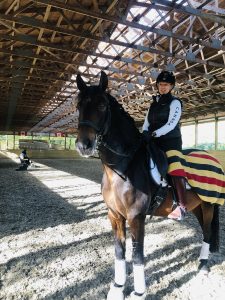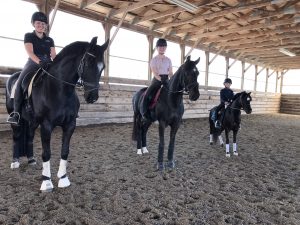 Blog #3 Critical Thinking & Yearly Training Plans
Blog #3 Critical Thinking & Yearly Training Plans
Sandra Verda Zanatta
Yearly Training Plans have been an important component of my equestrian career as both a HP coach and athlete. I have utilized YTP’s to guide my personal athletic development, the training and competition plans for my FEI horses, and my competitive riders’ paths to national and international competitions. YTP’s provided the framework for progressive training plans within a cohesive team atmosphere. For this blog, I decided to reflect on critical thinking and its role in the development of yearly training plans in equestrian sport.
Equestrian sport YTP cycles and preparation periods need to be well thought out. Adaptability and flexibility to address the evolving needs of individual horses and riders and the combination as a “team” is a constant theme in daily training, competitions and yearly planning. Sometimes horse and rider progression does not align, and we need to critically evaluate whether to take a step back or increase challenge and press on. The affect of potential decisions on both athletes and whether they support desired long and short term goals, need to be carefully considered.
Coaches need to be critical thinkers when analyzing, observing and evaluating riders and horses in order to develop appropriate training and competition plans. Due to the intricate partnership between horses and riders, there are numerous variables to consider as we develop plans and set short and long-term goals. Strategic consideration and analysis of the individual strengths and weaknesses of each athlete, their fitness level, and temperament, while promoting mental and physical well-being, is key to setting realistic, measurable goals that align with desired outcomes. Anticipating challenges, adjusting plans, and incorporating diverse training modalities are all aspects of how critical thinking is used in the development of equestrian YTP’s. Equestrian coaches need to be open-minded, willing to adapt and change course as needed.
Horses mature at different rates, and all have varying responses to pressure and training. Each ride requires analysis of soundness, gait regularity, fatigue and tension levels and adjustments need to be made throughout the session to address horse’s response to rider aids and chosen skill development exercises. Training horses and riders requires constant evaluation of training methodologies, seeking innovative approaches to enhance specific skills or address areas that require improvement. Open communication between coach/rider is important to allow rider feedback on how the horse “feels” so coaches can provide strategies to improve skills and exercises that can help rider achieve desired “feel”or result. Riding is kinesthetic and the most effective riders who train and compete through to the elite levels, have excellent body awareness, and an extraordinary ability to feel then adapt to the horse’s body and their response to subtle cues.
When evaluating a horse and rider team and their future potential or choosing horses for high performance sport, a critical eye is necessary. We consider health, size, temperament, conformation, muscle development, quality of gaits, suppleness, and training history. Comprehensive examination of these variables, as well energy levels, temperament and physical abilities of riders is required; the goal is to create successful, harmonious partnerships.
YTP planning also has to take into consideration travel and venue acclimatization for horses. Critical thinking and strategic planning are important components to address potential problems and develop plans to reduce stress, supporting positive outcomes. Horses have a flight instinct, weigh 1000 pounds plus, and are powerful athletes, so handlers, grooms, riders and assistants need to have appropriate skills to manage different horses’ temperaments and personalities, promoting safety in various environments, and decreasing risk. Forethought and proactivity are important factors in our sport.
Athlete input is critical in the YTP process. To facilitate critical thinking and brainstorming of innovative training ideas, I will often ask questions that start with:
- How do you want to handle….
- What are your ideas about dealing with these potential issues…..
- What are the steps you think are relevant to creating “this” outcome…….
- Based on our experience with this horse so far what can we anticipate upon arrival at show and during the 1st day of acclimatization and what is your plan?
This approach not only optimizes the potential for success in competitions but also fosters a healthy, progressive journey of improvement throughout the training year. It creates an atmosphere of teamwork, trust, engagement, and accountability. It teaches planning skills, promotes critical thinking, and empowers riders and other team members to be proactive, promoting confidence in their contribution to the process.
Over the years, I have used numerous YTP templates and feel that this one is the most comprehensive to date. Throughout the planning process, I had several discussions with Sara (athlete) around the training and conditioning approaches for the horse and herself. We reviewed past performances and the key issues encountered in competition. Sara is a seasoned rider and fierce competitor but lacks the formality of a structured, focused YTP. She has exceptional focus and resilience, however, needs more organization and prioritization to reach her long-term goal of qualifying for Pan Am trials. Her input to the YTP was valuable and she found that being involved in its development really challenged her to think about different aspects of her training and also her daily routines and habits. Working with Sara in the Pilates cross-training program has provided valuable information regarding her physical strengths and weaknesses, allowing us to identify the root causes of postural issues and muscular asymmetries and incorporate strategies into the YTP to improve her riding effectiveness.
Awareness of rider mental well-being and recognition of triggers that cause challenges to self-regulation and emotional control requires critical thinking to devise plans to mitigate unwanted responses. In competition, stress reactions are often significantly increased so thinking ahead and planning on part of both rider and coach are important. Sara’s YTP has a significant focus on these factors. Improving her ability to regulate and control intensity levels, developing relaxation techniques will be a focus throughout the upcoming season.
This coach/athlete partnership with Sara is fairly new and going through the YTP process together gave us both valuable insight into the strategies and techniques that may work for us as a team. It further developed our relationship and understanding of each other and has strengthened our partnership for the future.

 My equestrian leadership roles as coach, clinician, coach developer, committee chairperson and conference presenter have allowed me the opportunity to travel internationally and learn from some of the most renowned coaches, athletes and technical leaders in our sport. As I work through the HPCTL program, I am continually inspired and humbled by the wealth of knowledge imparted to me by the professors and fellow cohort, and as my passion has always been to educate and inspire others, I appreciate the course information and tools gained to recognize where I can improve and elevate my coaching and leadership practices.
My equestrian leadership roles as coach, clinician, coach developer, committee chairperson and conference presenter have allowed me the opportunity to travel internationally and learn from some of the most renowned coaches, athletes and technical leaders in our sport. As I work through the HPCTL program, I am continually inspired and humbled by the wealth of knowledge imparted to me by the professors and fellow cohort, and as my passion has always been to educate and inspire others, I appreciate the course information and tools gained to recognize where I can improve and elevate my coaching and leadership practices.